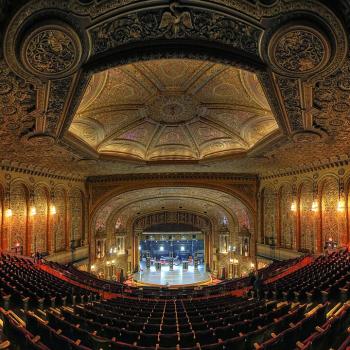
On Wednesday, December 23 I recorded a Christmas Eve sermon in the middle of the day, to an audience of two people (both related to me) and one camera on a tripod. My church mainly meets on Zoom in “real time” from our homes, so this was only the third time I had been back in the building and fully vested (in preacher duds, not in my portfolio) since March. The other two times were small, socially distanced services without Eucharist that we held in October as a tentative step back to in-person church before COVID case numbers all over the country went south. (Well, they got greater, so maybe they went north. You know what I mean.)
Even after ten months of disrupted church, I find myself still referring, as I lead the liturgy and preach, to the weirdness of it all. And yet, in another strange way, it has become that dreaded experience: the New Normal. I do remember that there was a time when I attended church and concerts and theater events in person, and went shopping without putting a mask on, and went to academic conferences while sitting somewhere else besides my own desk chair. So far, that Old Normal forms 98% of my life. But for my children, the Old Normal dips to 92% and 87%. There are toddlers, I am told, who don’t remember the Old Normal at all. And even now, when I see a picture of unmasked and undistanced togetherness from the Old Normal, my first reaction is fear before the fact dawns on me that I am watching the Old Normal and not the New.
In the Old Normal, I used my computer for work and my phone for recreation. I did not, except on very rare occasions (like the time in 2017 I got the flu and found the only Episcopal church in three dioceses which was streaming a service on Facebook Live) use electronics for worship. Now a time when we did not, in some way, think about how to bring church to those not physically located inside the church building seems quaint. Even though continual Zoom church, like continual Zoom everything else, can grow wearying, we have collected quite a few attendees who by virtue of health or job had not been able to show up at a specific place and time on Sunday morning for years. If we do not bring them with us when we finally go back inside the building again – however masked, distant, and music-less our return – we will be diminished.
The thing is, though, there are so many paradoxes about the New Normal in the context of worship. Christianity is an incarnational faith. Christmas Eve is our biggest witness to that. Am I glad that we were able to film it from inside the building to a physical audience of three? Yes. Was there still something important missing from our celebration without the rest of the people and the Real Presence of Christ in his holy meal? Also yes. After all the reminders I’ve heard repeatedly during these times that “the church is people, not a building” and “Anglicans need to rediscover our heritage of the Daily Office and not expect every service to be the Holy Eucharist,” I think it’s still OK to point out that those statements are not the whole story.
And yet, we are still embodied, even while we are sitting at our desks. We still have the flesh that Christ took on himself in the incarnation, even while staring at a computer screen. What we need, I think, is not a bifurcation between “real” and “online” life, but an awareness that all life is real life. Some kinds of real life are just more painful than others. (Or more distracting. It’s very, very hard to keep the focus on the Zoom screen for worship when every other screen on your device is calling out to you about undone work and unchecked social media. It requires a higher degree of willpower – for me, anyway – than just sticking the phone in my purse with the ringer off until in-person services are over.)
I’ve heard two different Christian responses to what the pandemic does to the imperative for Christians to gather together in Hebrews 10:25. One argument is that meeting online, masks, and distancing all get in the way of fulfilling Hebrews 10:25 because they make our being together not “real.” We have to be able to breathe each others’ air and touch each others’ hands for worship to “count.” While I don’t agree with this argument, I think it springs from a realization that humans were not made to be distanced from each other forever. It breaks something inside of us. (There’s even something in Genesis 2:18 about that.)
But the other response – to continue online worship as a fulfillment of Hebrews 10:25 without a serious theological interrogation of what it feels like and what it does to us – is equally problematic. It treats embodiment online as exactly equivalent to embodiment in person. Never mind that our hands, our eyes, and our voices all must do very different things in the two different environments, or that other people are manifested to us in vastly different fashions, or that some things that are possible in one environment (LIKE THE EUCHARIST, she shouts silently into her coffee) are impossible in another. We are still real. But we are real in the New Normal with expectations, theologies (even if only half-realized), minds, and bodies that were formed in, and for the Old. We are real in the midst of the paradox that Christ came to redeem and sanctify everything – even computers – but that, via computers, that sanctification seems forever doomed to be incomplete.
And so we wait, in an eternal Christmas Eve that never turns into Christmas Day, a Lent that never becomes an Easter, and in the most unordinary of Ordinary Times.
Image: Unsplash













